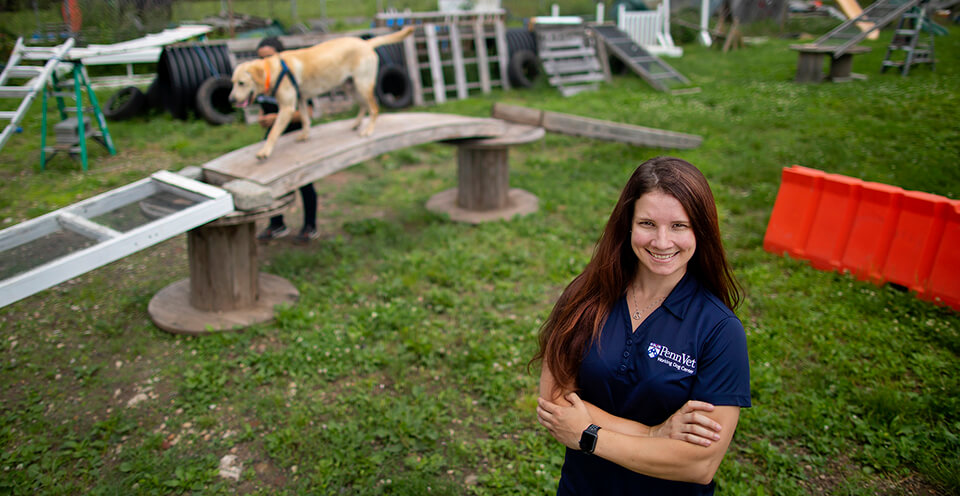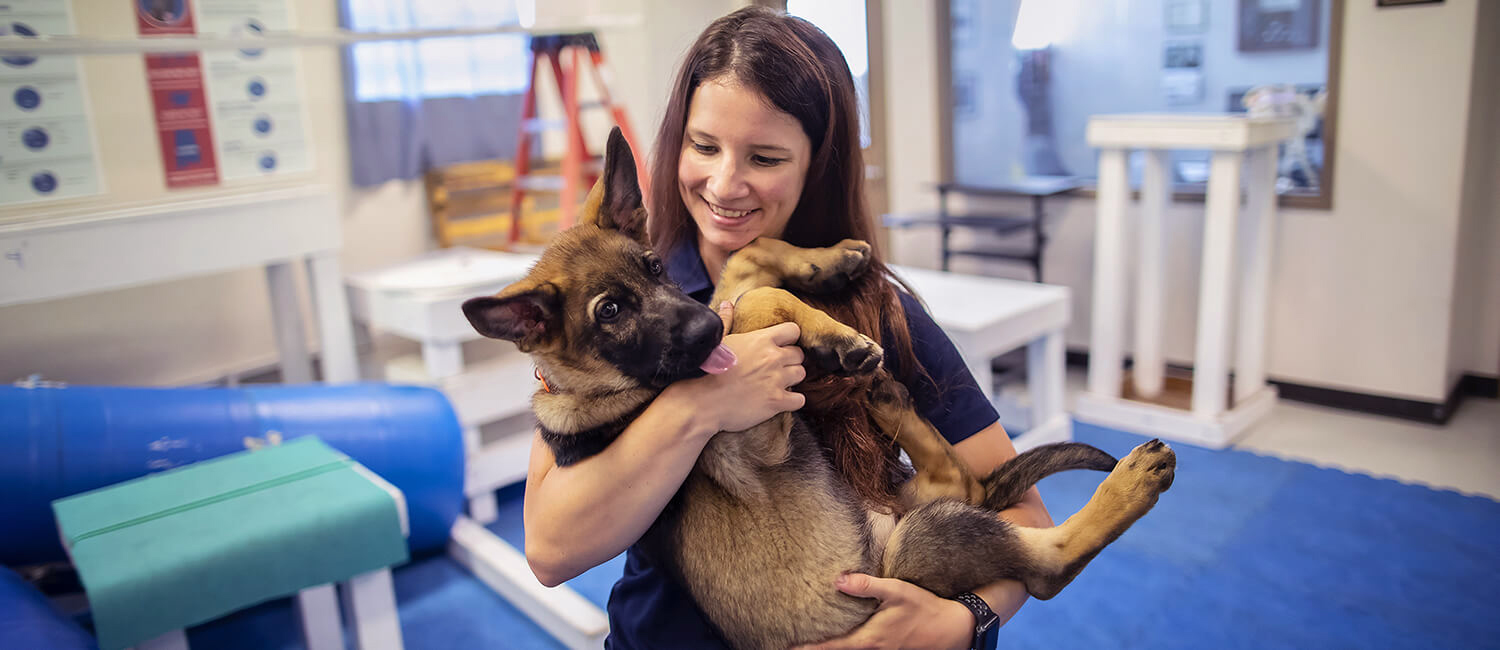 Recent Penn Vet graduate Meghan Ramos continues her dog scent detection research as a Penn Vet Working Dog Center fellow.
Recent Penn Vet graduate Meghan Ramos continues her dog scent detection research as a Penn Vet Working Dog Center fellow.
“Go, Osa!” says Meghan Ramos, a recent graduate of Penn’s Veterinary Medicine program. Osa, a German shepherd, runs over to a wheel, carefully sniffing one of eight arms that extend from the scent wheel’s center. At the end of each arm is a blood serum that contains either malignant or benign ovarian cancer, a normal, cancer-free serum, or a distractor scent. Osa’s trained to detect blood serums that contain malignant ovarian cancer.
Osa successfully finds the malignant serum and stares stoically at the sample. A trainer clicks a clicker. Osa breaks her stare and runs to the trainers for a treat, peering up affectionately at Ramos—or maybe the treats that she’s holding. “Good girl, Osa!” says Ramos.
Ramos works at Penn Vet’s Working Dog Center, where researchers and employees train working dogs for detection careers in medicine, law enforcement, and disaster response.
When Ramos was 8 years old, her dog—a golden retriever named Cali—was diagnosed with lymphoma. Around the same time, someone Ramos knew had lymphoma, too. She says this opened her young eyes to disease and the similarities between humans and animals.
Ramos says that because of this, and upon learning more about veterinary medicine’s widespread applications, she thought it was the perfect career. “I wanted a way to help people and help animals, and veterinary medicine fits that perfectly,” she says. “I also learned in undergraduate courses [at Rutgers] that I liked research, and there’s a big research component to veterinary medicine, so I got to combine all of my loves.”
In the summer of 2013, two years before her first semester in the Penn VMD program, Ramos started working at the Working Dog Center. Now, she’s leading a new research project that trains dogs to detect biofilm infections as she pursues a master’s degree in translational research through Penn’s Perelman School of Medicine. The MTR degree, a prestigious program funded by the National Institute of Health, usually only admits medical residents and fellows. But Ramos was not only awarded a place in the program—she also received a scholarship through a TL1 grant.
“I’m unique because I’m [studying] veterinary medicine. The program allows me to work with M.D.s and postdocs in the human medical world,” she says. “This will be a direct line of communication between the human and veterinary medical fields, which are traditionally separate. I’ll also get to work in the clinical setting.”
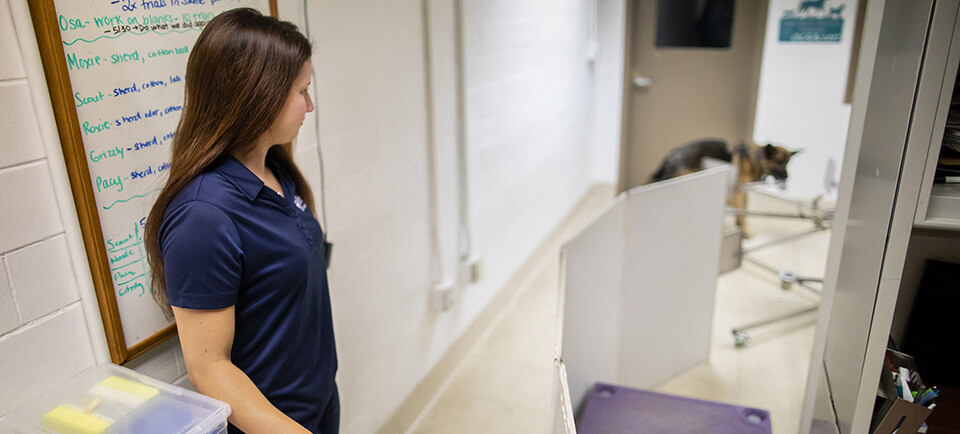 Meghan Ramos watches as Osa sniffs out the blood serum that contains malignant ovarian cancer.
Meghan Ramos watches as Osa sniffs out the blood serum that contains malignant ovarian cancer.
Ramos’s biofilm research has clinical potential, too. A biofilm consists of microorganisms that stick together in a slimy matrix. It can form on both living and non-living surfaces. Procedures such as knee and hip replacements can unfortunately lead to biofilm infections. Even worse, patients only realize there’s a problem when they start to experience pain and swelling near the implant, and by then the biofilm infection has already caused tissue necrosis and other damage.
Training dogs to detect biofilm infections is somewhat easy, says Ramos. “It starts with basic scent detection," she says. "We present them with a smell, in this case a biofilm infection, and then we give them a treat so that they associate that smell with a reward. We can teach them to detect any scent—everything is a game for them.” Thomas Schaer, director of translational orthopedic research and preclinical studies at Penn Vet’s New Bolton Center, is a collaborator on the project and provides biofilm samples for the dogs' scent training.
But Ramos jokes that bringing dogs into a hospital isn’t exactly practical. “I want to create a non-invasive test for early biofilm detection to find [the infections] before they cause destruction within the joints and around the implant location,” she says. “The dog’s scent detection is a tool to create an eventual test.”
The Working Dog Center collaborates with Penn Professor A.T. Charlie Johnson’s physics lab in the School of Arts and Sciences, where researchers study volatile organic compounds and potential applications of nanoparticles and chemical properties in medical devices. Researchers in the physics lab and at the Working Dog Center hope to eventually develop a medical device that mimics a dog’s sniffing capabilities.
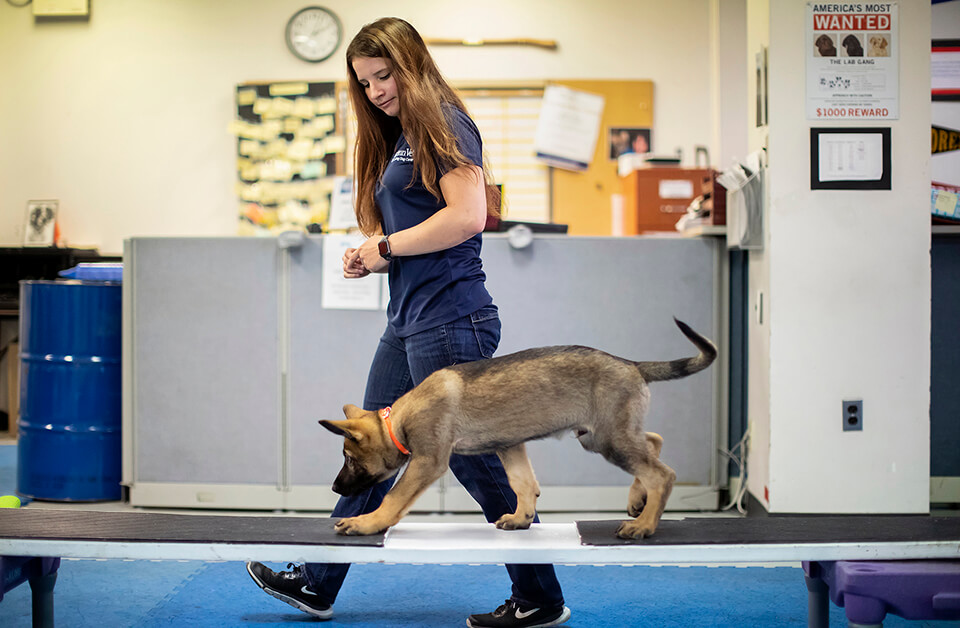 Ramos says that her biofilm detection idea was inspired by conversations with Cynthia M. Otto, as well as her ovarian cancer detection research. Otto, who directs the Penn Vet Working Dog Center, says she’s excited about Ramos’s biofilm detection research. The two have been working together since Ramos arrived at the Working Dog Center.
Ramos says that her biofilm detection idea was inspired by conversations with Cynthia M. Otto, as well as her ovarian cancer detection research. Otto, who directs the Penn Vet Working Dog Center, says she’s excited about Ramos’s biofilm detection research. The two have been working together since Ramos arrived at the Working Dog Center.
“Dr. Otto took me under her wing from the start, and my goal is to be like her one day,” Ramos says. “[Otto] is inspiring, she pushes limits, she’s caring and genuine, and she loves to teach.”
Otto says that when Ramos stepped into the Working Dog Center, she knew she’d be a great fit.
“[Ramos] is so self-effacing,” says Otto, “and she’s a natural leader. She’s constantly trying to make sure that she’s improving her own research and veterinary skills, but she’s also constantly ensuring that other people at the center are receiving the best education and guidance.”
Otto says that she’s watched Ramos become a doctor, a transformation that’s been both inspiring and rewarding.
“To watch just how all of this knowledge and information has been poured into her over the past five years, and to watch how it comes out in such an articulate way, is really like a piece of art. From the beginning she had her eye on her goal, and she’s taken every opportunity to build skills that will allow her to step into that role.”
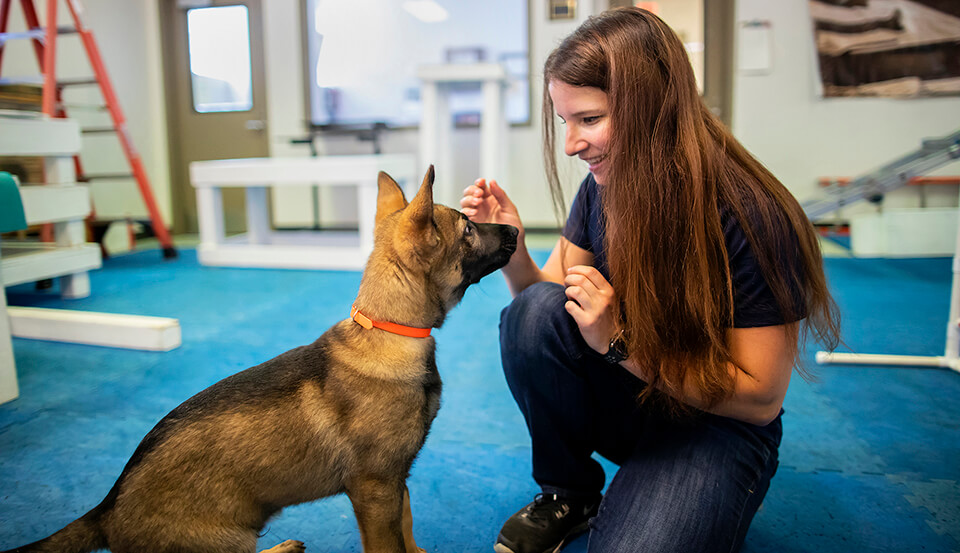 Ramos says she loves her colleagues—the people and the dogs. Ramos even fostered a “student” for a while. She gave Mizu, a German shepherd—which is Ramos’ favorite dog breed—a caring home. Mizu has graduated from the Working Dog Center and now works as a narcotics officer at the Pennsylvania Attorney General’s office.
Ramos says she loves her colleagues—the people and the dogs. Ramos even fostered a “student” for a while. She gave Mizu, a German shepherd—which is Ramos’ favorite dog breed—a caring home. Mizu has graduated from the Working Dog Center and now works as a narcotics officer at the Pennsylvania Attorney General’s office.
Though Ramos enjoys training dogs in scent detection, she also spends time teaching dogs search and rescue missions. She helps rehabilitate injured dogs, and she even develops the dogs’ fitness plans to help them avoid injury. In her spare time, she’d like to work in a veterinary emergency hospital, too.
But when Ramos speaks about the Working Dog Center, it’s clear that she finds her job rewarding and fulfilling.
“It’s the only place in the world like this,” she says. “We are a research, training, and education center, and on top of that we have a breeding program. Some places have breeding, and some have training, but no other centers have it all in one place. I’m really thankful to be a part of what Dr. Otto has established since the Center opened in 2012.”
But Otto says Ramos is more than just a part of the Working Dog Center.
“She’s generally an all-around amazing person,” Otto says. “She is our future.”
